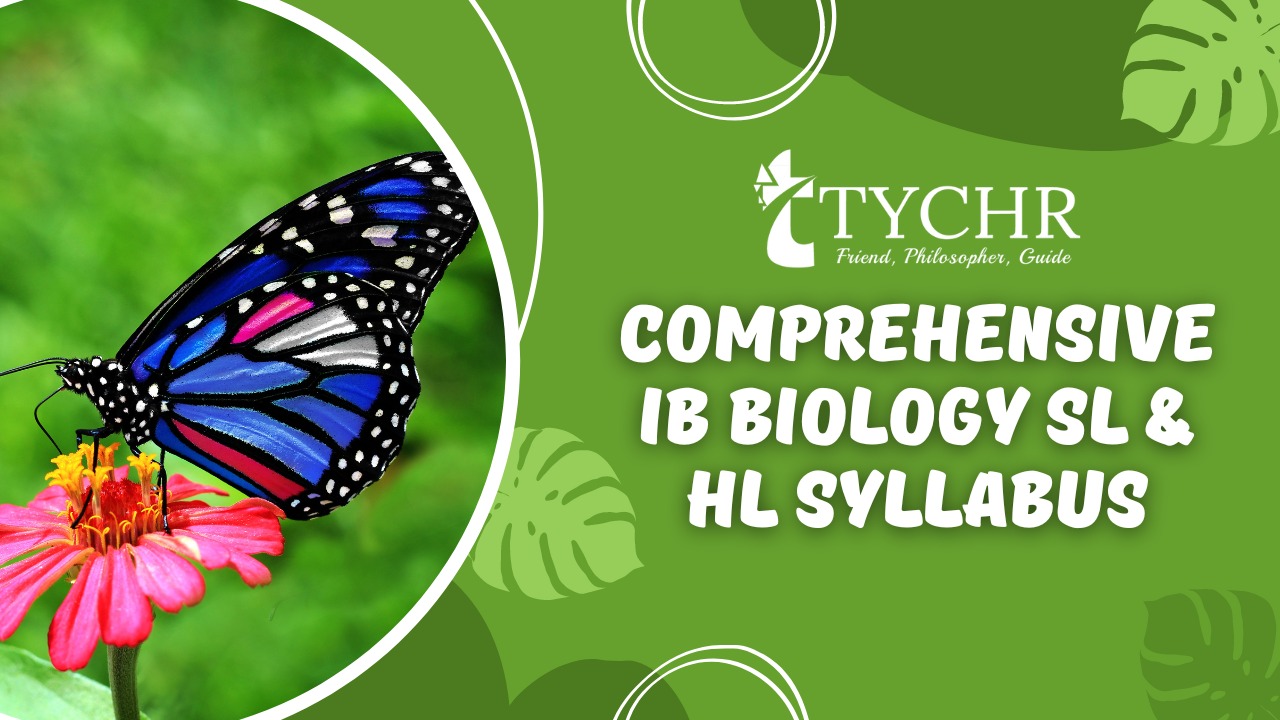Table of Contents
- 1 Unit 1: Cell
- 2 Unit 2: Molecular Biology
- 3 Unit 3: Genetics
- 4 Unit 4: Ecology
- 5 Unit 5: Evolution and Biodiversity
- 6 Unit 6: Human Physiology
- 7 Unit 7: Nucleic Acids
- 8 Unit 8: Metabolism, Cell respiration and photosynthesis
- 9 Unit 9: Plant Biology
- 10 Unit 10: Genetics and Evolution
- 11 Unit 11: Animal Physiology
- 12 Option A: Neurobiology and behavior
- 13 Option B: Biotechnology and Bioinformatics
- 14 Option C: Ecology and Conservation
- 15 Option D: Human Physiology
- 16 Frequently Asked Questions (FAQs)
- 16.1 Q1: What topics are covered in the IB Biology syllabus?
- 16.2 Q2: How is the IB Biology course assessed?
- 16.3 Q3: Which topics are given the most weightage during assessment?
- 16.4 Q4: How is the IB Biology course different from other high school biology courses?
- 16.5 Q5: What are the benefits of taking the IB Biology course?
Unit 1: Cell
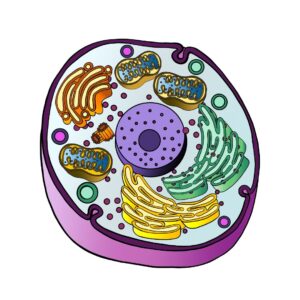
In this comprehensive IB Biology syllabus Unit 1, we’ll explore the characteristics of living things and why cells are so important. We’ll look at the differences between prokaryotic and eukaryotic cells, how they’re built, and what they do. Additionally, we’ll explore cell membranes and how things move in and out of cells.
| Subtopic | Subtopic Number | IB Points to Understand |
| Introduction to cell | 1.1 | Cell is the smallest collective functional unit a living organism can own.
Surface area to volume relativity ratio limits the size of the cell – More the surface area, more will be the movement of the materials in/out of the cell. Specific genes are involved in the production of certain types of cells, with each cell having the complete genetic information of the organism. Stem cells are the origin cells, from where the cell division starts and also they retain their ability to differentiate into various cell types. Different types of stem cells |
| Ultrastructure of cells | 1.2 | Two types of cells exist; prokaryotic and eukaryotic.
Structural parts of a prokaryotic:
and eukaryotic cells:
Eukaryotic cells in animals and plants |
| Membrane Structure | 1.3 | Phospholipid is made up of glycerol (3-C compound), which further includes fatty acids and alcohol group with phosphate.
Cholesterol molecules are not present in the plant cells but in animal cells. Two distinctive areas of Phospholipid bilayers are termed as hydrophilic (water-loving) and hydrophobic (water-fearing) |
| Membrane Transport | 1.4 | Active membrane transport: This transportation of molecules or substances requires energy which is provided in the form of ATP, because movement in this is against the concentration gradient.
Passive membrane transport: Does not require energy
Endocytosis and exocytosis: Endocytosis allows the molecules to enter the cell while exocytosis allows them to leave the cell. Fluidity (provided by bilayer structure) of the membrane is essential for these processes. |
| The origin of cells | 1.5 | Cells can only be formed by division of pre-existing cells.
The first cells must have arisen from non-living material. The origin of eukaryotic cells can be explained by the endosymbiotic theory. |
| Cell division | 1.6 | A cell cycle describes the growth and division phase of the cells. It occurs mainly in 2 parts; Interphase & M phase
Mitosis is the division of the nucleus into two genetically identical daughter nuclei. The division of cytoplasm into two daughter cytoplasmic cells is called cytokinesis. Cyclins mediate the cell cycle by binding to cyclin-dependent protein kinases (CDKs). Cyclins are involved in the control of the cell cycle.
An uncontrolled division of cells causes a cluster of unwanted cells in an area called tumour. Two types are found; primary tumour and secondary tumour. Mutagens, oncogenes and metastasis are involved in the development of primary and secondary tumours. |
Unit 2: Molecular Biology
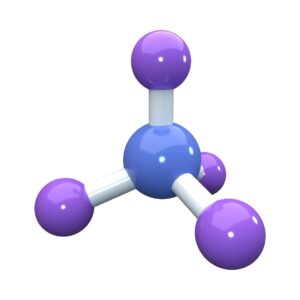
In Unit 2 of IB Biology, you’ll get to study Molecular Biology, covering areas like how molecules are involved in metabolism, the characteristics of water, carbohydrates and lipids, proteins, enzymes, the structures of DNA and RNA, and the four most commonly found elements in living organisms.
| Subtopic | Subtopic Number | IB Points to Understand |
| Molecules to metabolism | 2.1 | There are four biochemical molecules; Carbohydrates, lipids, proteins and nucleic acids. These four molecules interact to carry out metabolism.
Metabolism: Inside a cell, in an aqueous medium many molecular collisions occur, these collisions provide energy for the reactants to undergo chemical reactions. Anabolism is the synthesis of complex molecules from simpler molecules including the formation of macromolecules from monomers by condensation reactions. Catabolism is the breakdown of complex molecules into simpler molecules including the hydrolysis of macromolecules into monomers. |
| Water | 2.2 | Water is a covalently bonded structure involving one Oxygen and two Hydrogen atoms.
Properties: Cohesive, adhesive, thermal, solvent, and high boiling point Water works on the principle “like dissolves like” and dissolves only polar solutes, being polar molecules. These polar solutes are called hydrophilic. Hydrophobic (water-fearing) solutes like methane (CH4) do not dissolve in the water because they are non-polar. |
| Carbohydrates and Lipids | 2.3 | Carbohydrate is a kind of sugar. Monosaccharides (single sugar units) combined by condensation reactions to form disaccharides and polysaccharides.
When a hydrocarbon long chain has a carboxyl group at one end and a methyl group at the other, it is called saturated fatty acids. If one double bond exists in the chain of hydrocarbons, the fatty acid is then called monounsaturated fatty acids. When two or more double bonds are present, then it is called polyunsaturated fatty acids. Lipids get hydrolysed into two carbon segments which ultimately fulfil the energy requirements by the production of ATP through cellular respiration. |
| Proteins | 2.4 | Amino acids are linked together by condensation to form polypeptides, by the process called translation.
There are 20 different types of amino acids out of which 16 are polar and 4 are non-polar Ribosomes link these amino acids together and form polypeptides which can be of huge numbers. Two or more polypeptides bond together to perform a particular function, together they are considered as protein. Structure of proteins goes from the simple primary to the globular quaternary. Examples of proteins: Insulin, Collagen, Rubisco, Haemoglobin, etc |
| Enzymes | 2.5 | Enzymes are solely proteins that act as catalysts in the metabolic reactions that occur inside the cells.
They have an active site on which the substrate binds. Substrates and their active sites are specific for each other. Factors affecting enzymatic reactions:
Immobilised enzyme: These enzymes are trapped in tiny pores on beads of calcium alginate. Immobilised enzymes are used for the production of lactose-free milk. |
| Structure of RNA and DNA | 2.6 | Three types of nucleic acids are found in nature namely; adenosine triphosphate (ATP), deoxyribonucleic acid (DNA) and ribonucleic acid (RNA).
DNA contains deoxyribose pentose sugar while RNA contains Ribose pentose sugar. DNA differs from RNA in the number of strands present, the base composition and the type of pentose. |
| DNA replication, transcription and translation | 2.7 | DNA Replication occurs during the cell division in which the DNA content is doubled.
Transcription is the synthesis of mRNA copied from the DNA base sequences by RNA polymerase. Translation is the Process of synthesis of polypeptide with the help of cell organelle, ribosome.
|
| Cell Respiration | 2.8 | A variety of biochemical pathways that can be used to metabolise glucose in a cell is called cell respiration.
Glycolysis is the method of slow oxidation of the glucose using various enzymes. Fermentation is of two types; alcoholic fermentation and lactic acid fermentation Aerobic pathway of cell respiration: It involves complete oxidation of glucose into water + CO2 + ATPs. |
| Photosynthesis | 2.9 | The conversion of the light energy into chemical energy is called photosynthesis.
In the leaves of the plants, there is a presence of green colour organelle called chloroplast which contains the light absorbing pigment chlorophyll in it Photosynthesis gives off the oxygen and in the cellular respiration oxygen is taken in. Photosynthetic rate is affected by many external factors like light, temperature and CO2 concentrations. These are also called the limiting factors of the photosynthesis |
Unit 3: Genetics
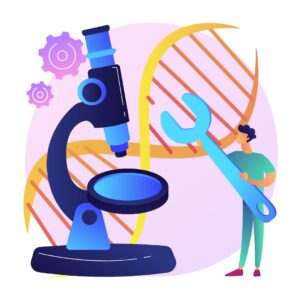
In this IB Biology Guide you’ll find out , Genetics involves the fundamental units of heredity, genes, which are composed of specific sequences of DNA bases carrying instructions for protein synthesis. Human DNA comprises roughly three billion bases, with over 99 percent being identical across all individuals. The Human Genome Project estimates humans possess between 20,000 and 25,000 genes, each person inheriting two copies, one from each parent.
| Subtopic | Subtopic Number | IB Points to Understand |
| Genes | 3.1 | Gene: A heritable factor that consists of a DNA sequence and influences a specific character or trait in an individual.
Alleles: These are the versions or a form of gene, differs with only one or few bases. Mutation: It is a sudden random change in the genetic material. The complete set of an organism’s base sequences of DNA is called its genome. The Human Genome Project was begun in 1990, with the aim to find all the base sequences of the human genome. |
| Chromosomes | 3.2 | The nucleoid region of prokaryotes like bacteria and archaea contains a single, long, continuous, circular thread of DNA.
When the cell is not dividing, the chromosomes (condensed form) are not visible, but the chromatin is there in the nucleus. Two chromosomes with the same kind of genes like in 23 pairs of human cell chromosomes. Ploidy is the number of sets of chromosomes that exist in a cell:
Karyotype is the picture of the chromosome of an individual and karyogram is the standard representation of the chromosomes in the order, according to shapes and sizes. The 23rd pair of chromosome is sex chromosome, as it determines the sex of the individual. |
| Meiosis | 3.3 | Meiosis is a special type of cell division which reduces the chromosomal content of a cell into exactly half of the original after its division, also called reduction division.
Meiosis I and II Down’s syndrome is one of the disorders and caused by an additional copy of chromosome number 21 i.e. when the 21st chromosome fails to separate during Anaphase I, creating trisomy of 21st chromosomes in the offspring. |
| Inheritance | 3.4 | Concept of inheritance was first put forward by Gregor Mendel in 1865.
Gametes receive one of the two alleles of a specific gene. And this allele could be dominant or recessive with respect to the other allele.
There are two kinds of genetic diseases in humans:
|
| Genetic modification and biotechnology | 3.5 | Gel Electrophoresis: This technique is used to separate DNA fragments (chopped out of long DNA strands by the action of enzymes), according to their sizes.
Polymerase chain reaction: This technique is used to amplify the gene of interest obtained from gel electrophoresis, using a thermocycler. DNA Profiling: This is the process for matching an unknown sample of DNA with a known sample to see if they correspond. The technique of transferring a gene of interest from one organism (donor organism) to other organism (host organism) to modify them in search of availing more benefits, also called as recombinant DNA technology. Clones: These are the exact copy of the individuals already exist, made by using genetic techniques Genetically Modified Organisms (GMOs) are called transgenic plants or transgenic animals |
Unit 4: Ecology
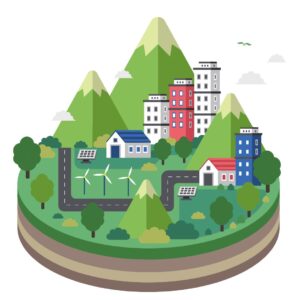
Ecology explores the interactions between organisms and their surroundings, encompassing the distribution and abundance of organisms, energy flow, and nutrient cycling.
| Subtopic | Subtopic Number | IB Points to Understand |
| Species, communities and ecosystems | 4.1 | Habitat: A natural environment in which an organism live.
Ecosystem: Sum total of biotic and abiotic components of a particular geographical area being integrated through exchange of energy and nutrient cycling. Decomposers are the organisms which help in breakdown of the organic waste material and dead animal and plant matter into inorganic useful material. Species: It is a group of organisms that can interbreed and produce fertile offspring Detritivores are heterotrophs that obtain organic nutrients from detritus by internal digestion. Saprotrophs are heterotrophs that obtain organic nutrients from dead organisms by external digestion. |
| Energy flow | 4.2 | Every position which is occupied by certain organisms in the food chain is called its trophic level.
The interlinking of two or many food chains is called food web. Autotrophs absorb the sunlight and take up inorganic nutrients from the soil to make organic food for the rest of the food chain. This loss of the energy is in the form of heat which can’t be used ever again but then contributes to global warming. |
| Carbon Cycling | 4.3 | In the carbon cycle, the producers takes up the carbon in the form of CO2 and converts it into and organic carbohydrate, glucose
Methanogens (members of Archaea) produce methane (CH4) as a waste gas while metabolizing its food. Methane is found in natural gas and its oxidation produces CO2 Peat is a dark coloured, waterlogged soil mixture of dead organic matter, found in wetlands. Limestone: Many organisms in the oceans takes up the dissolved CO2 from the water and form their carbonated shells and coral polyps takes up the carbonate ions and calcium which combines to form calcium carbonate |
| Climate Change | 4.4 | Greenhouse effect refers to the ability of a planet to use its atmosphere to retain heat and warmth even when no sunlight is hitting the surface.
Greenhouse gases (GHGs) include water vapour, CO2, CH4, nitrous oxide (NO2) etc |
Unit 5: Evolution and Biodiversity
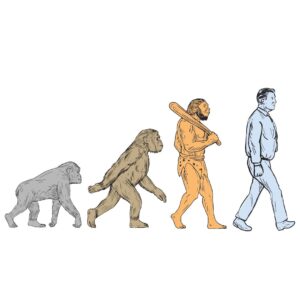
Evolution, the process of life’s transformation over generations, leads to the incredible diversity of organisms present today. Biodiversity encompasses the variety of life on Earth, including species diversity, genetic diversity, and ecosystem diversity.
| Subtopic | Subtopic Number | IB Points to Understand |
| Evidence for evolution | 5.1 | Evolution: It is defined as the cumulative gradual or sudden change in the heritable characteristic of a population.
Fossils are the petrified remains or traces of animals and plants and the accumulated evidence from these remains are called fossil record. Adaptive Radiation refers to the development of different functional structures from a common ancestral form. Animal Breeding: The breeding of animals and plants is done artificially by selecting the best individual with the desired traits and crossing them to get the product with the desired trait. Homologous structures: The structures which are anatomically the same but perform different functions and focus on common ancestors. Adaptive radiation: It refers to the development of different functional structures from a common ancestral form. |
| Natural Selection | 5.2 | Alfred Wallace and Charles Darwin support this idea as a mechanism of evolution in species over time.
Sudden drastic change in the DNA sequence due to external or internal factors which produces variation in an organism is called mutation. Meiosis: Random orientation of the chromosomes at metaphase offers variation every time the gamete forms. The organism that is well adapted to its environment has better chances of survival than the one which is less adapted. |
| Classification of biodiversity | 5.3 | The system of naming an organism using two names is called binomial nomenclature.
All the organisms that exist or existed (with the exception of viruses because they are considered as non-living) are classified into three domains namely; Archaea domain, Eubacteria domain and Eukaryote domain. Further classification occurs by classification of the organism into seven different taxa: Kingdom, Phylum, Class, Order, Family, Genus and Species Plant and Animal Phyla Vertebrates are classified into class: Fish, Amphibians, Reptiles, Birds and Mammals |
| Cladistics | 5.4 | Cladistics is an example of natural classification which classifies taxa together according to the characteristics that have evolved more recently. And a clade is the group of organisms that have evolved from the common ancestor.
Two types of traits: Plesiomorphic and Apomorphic traits Mutations in organisms occur roughly at the same rate and therefore the number of differences in sequence can be used to deduce how long ago species split from a common ancestor. This is how it works as an evolutionary or molecular clock. Cladograms are tree diagrams that show the most probable sequence of divergence in clades. |
Unit 6: Human Physiology
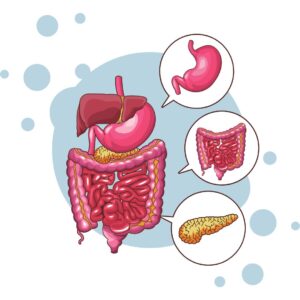
Human physiology investigates the functioning of the human body, including its systems and processes that maintain balance (homeostasis) and support survival.
| Subtopic | Subtopic Number | IB Points to Understand |
| Digestion and Absorption | 6.1 | Digestion: It is a series of events takes place for the breakdown of ingested food into smaller molecular forms, with the help of enzymes
Pancreas: It is a Multipurpose organ which produces two hormones named insulin and glucagon which metabolise glucose and pancreatic juice. Liver: It is the largest organ in the human body. The hepatic lobules are the structural and functional units of liver, from where bile juice is secreted into the small intestine for digestion purposes. Small Intestine: It is a four-layered tubular structure with the lumen and villi (facing lumen) on the innermost layer mucosa. Each villus contains a capillary bed for absorbing and transport of digested monomers. |
| The blood system | 6.2 | Arteries: These are the blood vessels that take blood away from the heart to supply the different organs of the body.
Veins: These blood vessels take blood from different organs of the body towards the heart. Capillaries are single-celled thick therefore the blood cells enter the capillaries at the rate of one cell at a time. Right side of the heart offers pulmonary circulation and the left side of the heart offers systemic circulation. A specialized tissue called sinoatrial node (SA node) is present in the right atrium, it is also known as pacemaker. SA node has the properties of both muscles and nervous system. Atrial systole: The sinoatrial node generates the signals and both the atria go into contraction Ventricular systole: The atria relaxes (atrial diastole) but the ventricles now contract The lub and dub sound (heart beat), the heart makes comes from the closure of the atrioventricular valves and the semilunar valves respectively. |
| Defence against infectious disease | 6.3 | Pathogens are the most likely threat to humans and to prevent them from entering into our body primary defence comes into action.
Skin and mucous membranes offers the major primary defence towards the Secondary defence: When the pathogens somehow pass through these primary physical barriers then it comes into action. Leucocytes (WBC) are the cells that tackles pathogens provides immunity against them Antibodies are the Y-shaped protein molecules which help in fighting against the invading foreign cells Antibiotics: It disfigures the biochemistry of the bacterial cell wall and deactivates them in such a way to stop their metabolism in many ways without harming the human eukaryotic cells which lack a cell wall. |
| Gas Exchange | 6.4 | The process of taking in the oxygen and giving off the CO2 is called cell respiration
The filling and expiration of the air in and from the lungs is called ventilation. Inspiration: While breathing in diaphragm contracts, external intercostal muscles with abdominal muscle raise the rib cage to increase the volume of thorax. Journey of air: Trachea → Left and right primary bronchi → smaller branches of bronchi → bronchioles → alveoli. Type I pneumocytes: Thin, large membrane surface area, capable of diffusion and if damaged cannot be replaced due to incapability of performing mitosis. Type II pneumocytes: Thick, cuboidal, have smaller membrane surface area. They produce surfactants which prevents alveolus membrane from sticking together. |
| Neurons and Synapses | 6.5 | Neurons are the fundamental cells of the brain and nervous system, designed to transmit information in the form of electrical impulses to other nerve cells.
The highly developed nervous system has neurons with myelin sheath around axons, called myelinated neurons. And other kind does not have myelin sheath around axons and are called non-myelinated neuron When a voltage or potential difference is maintained across the membrane and the neuron is not transmitting any impulse then it is called resting potential of that neuron. Action potential is the nerve impulse and consists of depolarization and repolarization. Repolarization: It is the change from positive to negative by opening of the potassium ions and closing of the sodium ions at the same time. |
| Hormones, Homeostasis and reproduction | 6.6 | Homeostasis: It is the tendency of the human body to maintain a stable equilibrium of certain physiological variables like blood pH, body temperature, blood-glucose concentration, blood-CO2 concentration and osmotic balance within tissues.
Hormones are the non-nutrient chemical messengers which are produced in trace amounts. Thyroxin: Produced and secreted by butterfly-shaped thyroid gland. Leptin (appetite-controlling hormone): Produced by adipose tissue in the body. More fat, the more the secretion of leptin into the blood. Melatonin: Produced by pineal gland present in the brain and helps to maintain the 24-hour cycle of activity called the circadian rhythm. Insulin and Glucagon: Produced and secreted by pancreas and regulates blood sugar levels. Human Reproduction: It involves the fusion of male gamete (sperm) and female gamete (egg) to form a zygote Sex determination: Male has XY pair and female has XX pair of chromosome. Menstrual Cycle: It is the hormonal cycle that begins after hitting puberty in human females. Each cycle lasts for approximately 28 days however, it differs from person to person.
In vitro fertilisation: It is a method of artificial reproduction in which egg and sperm are fertilised in vitro |
Unit 7: Nucleic Acids
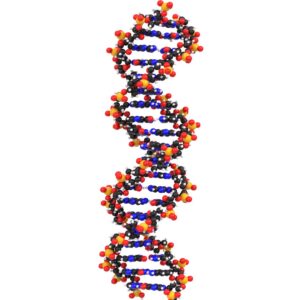
Nucleic acids like DNA and RNA store and transmit genetic information. DNA is composed of four chemical bases—adenine (A), cytosine (C), guanine (G), and thymine (T)—arranged in specific sequences, analogous to letters forming words, sentences, and paragraphs.
| Subtopic | Subtopic Number | IB Points to Understand |
| DNA structure and replication | 7.1 | DNA was confirmed as the genetic material by Alfred Hershey and Martha Chase in 1952, in their experiment using radioisotopes
DNA is a double stranded structure, with each strand consisting of alternating deoxyribose sugar and phosphate molecules as a backbone. There are 4 nitrogenous bases: Adenine and Guanine (Purines) and Cytosine and Thymine (Pyrimidines) The negatively charged DNA wrapped around the positively charged histones to make a bead-like structure called the nucleosome. DNA Replication: This process occurs during the cell division in which the DNA content is doubled. This is also an enzyme catalysed process involves helicase and DNA polymerase |
| Transcription and gene expression | 7.2 | One of the two major sets of reactions leading to protein synthesis, other is translation.
Genes are present on the DNA inside the nucleus and the protein synthesis occurs outside the nucleus in the cytoplasm. Therefore the mRNA (messenger RNA) acts as the intermediary molecule to transfer the information for protein synthesis from nucleoplasm to cytoplasm. The strand which has the same base sequence as that of mRNA (while having uracil in the place of thymine) is called sense strand. And the other template which has a complementary base sequence is called antisense DNA strand. Slicing: This is post-transcription process for removal of non-coding sequence called introns Methylation of any gene expression could prevent transcription |
| Translation | 7.3 | Translation: Process of synthesis of polypeptide with the help of cell organelle, ribosome.
Process: Initiation, Elongation, Translocation and then repeats Two or more polypeptides bond together to perform a particular function, together they are considered as protein. All the organisms are found to be genetically different due to specific DNA sequences called the genome and so their proteome. Structure of proteins goes from the simple primary to the globular quaternary. It possesses a three-dimensional shape (specific shape for the particular function). |

Unit 8: Metabolism, Cell respiration and photosynthesis
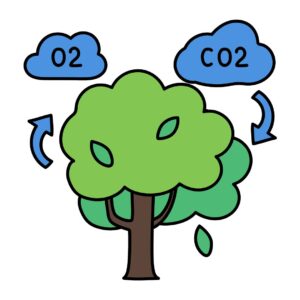
Metabolism encompasses the chemical reactions occurring in living organisms to sustain life, including cell respiration and photosynthesis.
| Subtopic | Subtopic Number | IB Points to Understand |
| Metabolism | 8.1 |
|
| Cell Respiration | 8.2 | Cell respiration is a catabolic pathway.
The reduced molecule has much more potential energy than the oxidised form of molecule, therefore the energy is released when the glucose gets oxidised. Glycolysis is the method of slow oxidation of the glucose using various enzymes If no oxygen is available, the pyruvate molecules enter the anaerobic pathway followed by fermentation. There is a direct transfer of a phosphate group from a phosphate bearing molecule (phosphoenolpyruvate) to ADP in order to make ATP. The process is called substrate-level phosphorylation. Krebs cycle Electron Transport Chain – It is the series of protein complexes called cytochromes and organic molecules to pass on the electrons from one member of the chain to another in a series of redox reactions. The coenzymes NADH and FADH2 released in previous cycles act as the sources of electrons. NADH allows the production of three ATPs and FADH2 allows the production of 2 ATP molecules. Chemiosmosis is the process in which movement of protons occurs to provide energy for phosphorylation. An enzyme called ATP synthase is embedded in the inner membranes of the mitochondria which facilitates ions across. |
| Photosynthesis | 8.3 | The conversion of the light energy into chemical energy is called photosynthesis.
Light Dependent reactions:
Light Independent reactions:
18 molecules of ATP and 12 molecules of NADPH are necessary to produce one molecule of glucose. |
Unit 9: Plant Biology
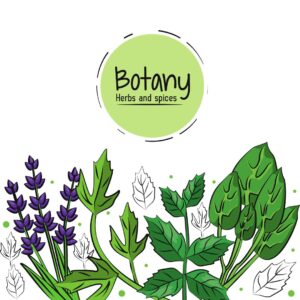
Plant biology concentrates on the study of plants, including their structure, growth, reproduction, and adaptation to their environment.
| Subtopic | Subtopic Number | IB Points to Understand |
| Transport in the xylem of the plants | 9.1 | Cohesion: It is the force of attraction between the molecules of the same substance like in water.
Adhesion: It is the force of attraction between the molecules of different substances Xylem: It is involved in supporting the plant and act as water conducting tissue of terrestrial plants. Stomatal Activity: Stomatal pores open and close by change in the turgor pressure in the guard cells Cohesion-tension theory: This theory explains the movement of fluid in plants. It takes into account the concentration gradients, cohesion between the water molecules, adhesion between the water molecules and walls of the xylem and tension created by all these phenomena. Roots absorb water and mineral ions necessary for plant growth which can be done passively, actively or by the action of fungal hyphae. |
| Transport in the phloem of plants | 9.2 | Phloem is made of living cells and helps in transport of the organic molecules. The main composing cells are sieve tubes and companion cells.
Phloem translocates molecules in various directions inside the plant but follows the principle of source to sink flow. Sugar is loaded in the sieve tube from the source (leaves). The formation of concentration gradients forces water from surrounding cells to enter the sieve tube as well. Water uptake inside the sieve tube creates hydrostatic pressure which helps in flowing of the sugar to the sink (any fruit or root). |
| Growth in plants | 9.3 | Plants show indeterminate growth pattern
Meristematic tissue composed of cells which have the ability to divide on its own by keeping one cell as its origin. Apical meristems: These are the primary meristems occurring at the tips of roots and stems. The developing tip tissue with apical meristem collectively called as shoot apex. Lateral meristems: These are responsible for secondary growth which allows growth in the thickness of plants. Hormones are the chemical messengers and in plants they are released in response to an environmental stimulus. Auxins are the group of plant hormones that can be produced artificially but produced naturally at apices of stems and roots. They influence the tropism of the plant. The growth of the plant in response to light is called phototropism. |
| Reproduction in plants | 9.4 | Flower bearing plants are called angiosperms. Flowers are the reproductive organs of the plants.
Monocots and Dicots Four basic flower parts: Sepals, Petals, Stamen and Carpel Pollination: It is the process by which pollen grains from the anther lands on the stigma of the same or another flower by means of wind, insects, water, birds etc Fertilization: It is the process of union of male and female sex cells to form a unit called zygote. Seeds: These are the structures that keep the embryo functional and protected. Plants react to the sunlight as they grow. This reaction to light features three types of flowering: Long-day plants, Short-day plants, Day-neutral plants Phytochrome is the pigment in the plants to offer control by light. |
Unit 10: Genetics and Evolution
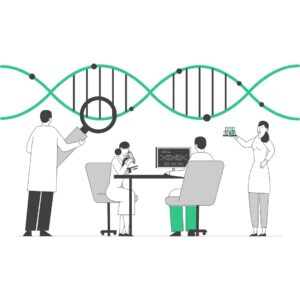
Genetics and evolution are intertwined disciplines; genetic variation serves as the basis for evolution, and genetic studies enhance our comprehension of evolutionary processes.
| Subtopic | Subtopic Number | IB Points to Understand |
| Meiosis | 10.1 | Meiosis: Replication of chromosome and joining of two copies of chromosomes with each other by centromere.
Crossing over: Exchange in DNA material between non-sister chromatids. It is an enzyme-mediated process and the enzyme involved is recombinase. Chiasma forms while crossing over. It is a point of adherence of two non-sister chromatids for efficient exchange of genetic material. Crossing over produces new combinations of alleles on the chromosomes of the haploid cells. Law of independent assortment: It states that the separation of one pair of alleles between the daughter cells is independent of another pair of alleles. |
| Inheritance | 10.2 | Law of Segregation: It states that during the formation of the gametes the pair of alleles for a specific trait separates such that the offspring receive one allele from each parent.
When two genes are found on the same chromosome they are called linked. The tendency of these genes to pass on to the next generation together is called linkage. Continuous variation deals with the spectrum of phenotypes and shows an unbroken range of phenotypes of a particular character. While discontinuous variation deals with few phenotypes and can show two or more forms of a particular character. Chi squared tests: These are the tests done to actually check the accuracy of possible ratios come by crossing. |
| Gene pools and speciation | 10.3 | Gene pool: All the genetic information present in the reproducing members of a population at a given time.
Change in the allele frequency leads to evolution. Hardy-Weinberg equation; It is the equation to calculate the allele frequency, genotypes or phenotypes within a population. Variation in allelic frequency by natural factors leads to different types of selection of equilibrium: Directional, Stabilising, Disruptive Some factors cause the hindrance in a major proportion which fall apart the populations and causes barrier in reproducing together: Geographical, Temporal and Behavioural All the reproductive isolation factors lead to speciation The rate of speciation can be judge by two ways: Gradualism and punctuated equilibrium |
Unit 11: Animal Physiology
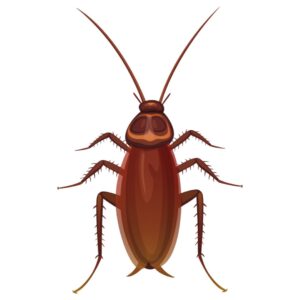
Animal physiology explores how animal bodies function, including the myriad systems and processes responsible for maintaining equilibrium (homeostasis) and ensuring survival.
| Subtopic | Subtopic Number | IB Points to Understand |
| Antibody production and vaccination | 11.1 | Immune system recognizes any foreign cell through antigens.
Antigens are polysaccharide and proteins, present on the surface of the cell. Immune response:
B cells are less in number while initiating the response but they clone themselves (undergo mitosis) to produce large amounts of antibodies. Histamines are the chemical which causes allergy symptoms like sneezing, congestion, itching, red skin etc. i.e. histamines are the cause of allergy. Memory cells stream in blood vessels but remain inactive until the pathogen it is specific to, attacks again. Vaccine: A vaccine contains attenuated or killed pathogens or their derivatives to generate the primary response in human’s body against the pathogen Monoclonal antibodies are specific antibodies for only one type of antigens i.e. they are exactly the same. B cells are fused with cancer cells called myeloma cells so that the leukocytes remain alive for a long time. The fusion of B cells and myeloma cells makes up hybridoma cells (hybrids of antibody producing cells and are long-lived myeloma cells). |
| Movement | 11.2 | Bones together make up a structure called skeleton, it can be made up of bones (endoskeleton) or chitin (exoskeleton).
Some bones act as levers to facilitate movements of some bony parts. Muscles work antagonistically in pairs to contract and relax at the same time, causing movement of the bone. Bone-to-bone joints are:
Muscle is composed of thousands of cells called muscle fibre. They are multinucleated and have specialised endoplasmic reticulum. There occur many parallel elongated structures called myofibrils inside the muscle fibre which is packed with the mitochondria to provide ATP at the time of muscle contraction. Myofibril is made up of sarcomere units which give it dark and light bands. Myosin gives dark shade and actin gives light shade. An action potential is generated by the nervous system carried by motor neurons to the sarcolemma. Ca+ ions bind to the troponin protein which stimulates the tropomyosin to slide over & uncover the binding sites of actin. |
| The kidney and osmoregulation | 11.3 | There are three types of nitrogenous wastes; ammonia, urea and uric acid.
Insects have specialised structures called Malpighian tubules. These tubules are close from one end and open from the other, the blood travels inside the tube and undergoes selective reabsorption. Kidneys filter blood and separate out the waste products. It produces urine which is a combination liquid of water and waste products (from the blood). Nephrons are the constituents of the kidney. Renal artery brings unfiltered blood to the kidney and renal vein takes filtered blood away from the kidney. Parts of nephron; glomerulus, Bowman’s capsule (surrounding the glomerulus), proximal convoluted tubule (PCT), loop of Henle, distal convoluted tubule (DCT) and a peritubular capillary bed surrounding these tubules. Filtrate flows into the lumen of single-celled thick PCT which is lined by microvilli for better reabsorption. The response mechanism of the body to maintain the water balance is called osmoregulation Loop of Henle has two portions; descending portion and ascending portion ADH (antidiuretic hormone) is secreted from the posterior pituitary and makes collecting duct permeable to water so that excess water moves out due to osmosis The animals which are having different solute concentrations compared with that of the environment are called osmoregulators. The animals which have same solute concentrations as that of surrounding environment are called osmoconformers |
| Sexual Reproduction | 11.4 | The process of formation of spermatozoa (sperm cells) is called spermatogenesis. The process occurs in the small tubes called seminiferous tubules inside the testes.
The process of formation of ovum is called oogenesis. Spermatogenesis and oogenesis both involve mitosis, cell growth, two divisions of meiosis and differentiation. The fusion of male and female gametes is called fertilisation. It can be internal or external Human fertilisation: Millions of sperms are ejaculated at the time of copulation, which travel into the Implantation: After fertilisation, mitotic division starts. It is now called blastocyst with a surrounding layer called trophoblast. Placenta is formed from mother and embryonic tissue. The exchange of fresh nutritive blood and deoxygenated blood with waste products occurs through the blood vessels in the umbilical cord of the placenta. Embryo secretes hCG hormone which enters the mother’s bloodstream and maintains the hormonal balance, which further releases the progesterone to maintain the endometrium corpus luteum. A small amount of oxytocin hormone is released by pituitary which causes uterine contractions. Contractions signal to release more oxytocin. Uterine contractions lead to parturition (baby comes out). |
Option A: Neurobiology and behavior
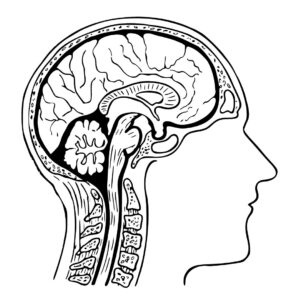
| Subtopic | Subtopic Number | IB Points to Understand |
| Neural Development | A.1 | Formation of neural tube
The process of formation or synthesis of neurons by differentiation of the neuroblast cell is called neurogenesis. An axon grows from each immature neuron in response to chemical stimuli. Mechanism of elongation of the axon of the neuron: A growth cone is present at the tip of the axon which directs it. Target cells are present at the final position of the neurons which produce chemical messages, to which the neuron responds by forming the synapse. Multiple synapses are formed during early brain development Neural pruning: The removal of unneeded connections eventually at the adult stage with the help of microglia cells and it leads to better brain efficiency. Plasticity of the nervous system: It signifies that the brain has the ability to reform and adapt according to perform functions as per need. 2 types: Functional and Structural |
| The Human Brain | A.2 | The human brain controls and produces every emotion, thought, feeling, memory. Also the involuntary actions like cardiac heart-beat, peristalsis etc. are controlled by it.
The neural tube has two ends; Anterior end and Posterior end, which develop into the forebrain and rest of the other parts of the brain, respectively. Different parts of the brain constitutes to different functions Brain and spinal cord are parts of the CNS (Central Nervous System), the other parts are covered by PNS (Peripheral Nervous System). ANS is further divided into sympathetic and parasympathetic systems. When a person shows no movements of extremities like legs and arms, no eye movement, absence of corneal reflex, absence of pupil reflex, absence of gag reflex, no respiration then the person is considered to be brain dead. The cerebral cortex covers the largest part of the mature brain i.e. cerebrum, formed from the front part of the neural tube. The left cerebral hemisphere receives sensory input and controls muscle contraction |
| Perception of stimuli | A.3 | Types of receptors:
All these receptors send messages to the central nervous system, which process the signals. Retina- Photoreceptor cells are present here. Rod cells receives very dim light enables black and white vision while cone cells receives bright light The light falling on this retina travels through ganglion cell layer, bipolar cell layer and then the receptors rod and cone cells which then transfer information through the nerve fibres to the brain. The bones in the middle ear, malleus, incus and stapes receive vibrational sound The semicircular canals help in maintaining the equilibrium. |
| Innate and Learned Behaviour | A.4 (HL) | Innate behaviour: It is an inherited behaviour from parents and therefore has no influence of environmental factors in establishment.
Taxis: It is a directed response to a stimulus. Kinesis: It is the response of an organism towards non-directional stimulus like some factor surrounding them such as humidity. Learned behaviour: It is not genetically inherited but develops as a result of experience by time. Imprinting: It is a rapid learning process by which an organism develops attraction and recognition of another moving object regardless of the consequences. Operant conditioning: It creates an association between behaviour and its consequences for an animal. Memory: It is the process of encoding the information, storing it and then accessing it while putting it into use. |
| Neuropharmacology | A.5 (HL) | Neurotransmitters: These are the chemicals made by neurons which act as a message to transmit to the respective neuron.
Neurons communicate through synapses using neurotransmitters Types of neurotransmitters (NTs) according to the responses they show; excitatory and inhibitory neurotransmitters. Types of neurotransmitters (NTs) according to the rate of activity; slow-acting NTs and fast-acting NTs. Psychoactive drugs: These drugs affect the postsynaptic transmission and thereby alter the functioning of Drug addiction: It may be defined as the cravings and intake of the drugs again and again due to loss of control or limiting. Anaesthetics: These are the molecules that can block the sensory reception and cause loss of sensation in any part or the whole body. |
| Ethology | A.6 (HL) | The study of animal behaviour in natural conditions is called ethology.
Natural selection also influences the animal behaviour. |
Option B: Biotechnology and Bioinformatics
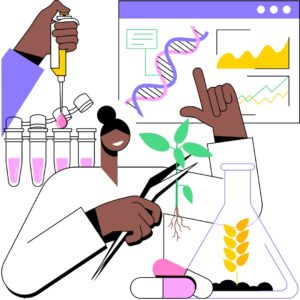
| Subtopic | Subtopic Number | IB Points to Understand |
| Microbiology: organisms in industry | B.1 | They are small, have fast growth rate and are metabolically diverse.
The genes of these microorganisms can be altered to increase their performance Pathway engineering: It is a method to alter or modify the genetic makeup of the microorganism to derive the products for human use. The process of large scale culture of microorganism to produce metabolites of interest using fermenters There are two types of fermentation; fed-batch and continuous fermentation. Anaerobic microbes work in the production of biogas by breaking down organic matter such as manure, plant matter and household organic wastes. Gram staining: It is a method of differentiating two groups of bacteria named; gram-negative and gram-positive bacteria. |
| Biotechnology in agriculture | B.2 | The technique of biotechnology makes it possible to have genetically modified crops (GM crops).
When a new gene is introduced in a species that offers production of the proteins that were not the part of its proteome earlier is called transgene and the organism possessing this gene is called transgenic. Genetically modification in crops may offer certain benefits like increased crop yields Recombinant DNA can be introduced by direct physical and chemical methods or indirectly by vectors. Means to transfer desired genes:
|
| Environmental protection | B.3 | Bioremediation: It is the process of using organisms, especially microorganisms to eradicate pollutants.
A biofilm is a film of aggregates of microorganisms that sticks to the surface due to cooperation between individual cells. Emergent properties: These are the properties shown by biofilms as a consequence of the unity of many different types of microorganism. Properties can be complex structures, Quorum sensing and resistance to antimicrobial agents. Advantages of biofilms include trickle filter beds and cleaning of water bodies |
| Medicine | B.4 (HL) | Genetic markers: These are the genetic variations in the DNA sequences if any disease is present.
The marker alleles are found more frequently in people affected with any disease. DNA microarray: It is a small surface having a collection of DNA probes attached to it which can be used to identify the genetic marker. Polymerase Chain Reaction: It is the most prominent tool in biotechnology to amplify any strand of DNA. ELISA: It is also a diagnostic tool, may be used to diagnose HIV and to test the presence of drug in blood and urine. Tracking experiments are done using a reporting element like green fluorescent protein (GFP) or radioactive probes to track the location or interaction of the protein molecule rolling inside the body. Gene Therapy: In this technique the viral vector could be retrovirus or adenovirus. Genetically modified animals or transgenic animals are also the means of biopharming. |
| Bioinformatics | B.5 (HL) | Bioinformatics is the collection of articles, images, quantitative and qualitative information etc. stored in the computer. It is prominent in genomics.
EST: It is a small fragment cDNA and can be used to locate or to determine the sequence of the gene Cladograms and Phylograms: These tools can help in constructing evolutionary relationship trees. BLAST: It is a tool used to search the databases and to find the regions of similarities between sequences BLASTn is for the nucleotide search whereas BLASTp is for the protein search, it compares the protein sequences. |
Option C: Ecology and Conservation
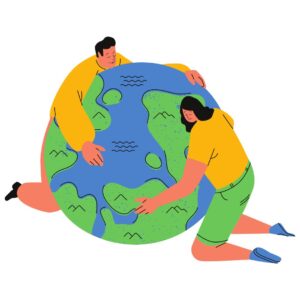
| Subtopic | Subtopic Number | IB Points to Understand |
| Species and communities | C.1 | The group of organisms living in a habitat, comprising related features and are capable of interbreeding, is called species.
When more than one species inhabits an area then it is called population. Group of populations living together and interacting with each other is called a community. Abiotic and biotic factors sometimes act as limiting factors which results in distribution of the species according to their tolerance of limiting factors. Keystone species: These are the species with high significance to maintain an ecological community. When two species in an area depend upon the same limited resource and if one of them gets a slight advantage, will be better adapted. Interspecific interactions:
Transect is a method of sampling a population of plants or animals along a longitudinal section of an ecosystem. |
| Communities and ecosystems | C.2 | Pyramid of energy shows the available energy at each trophic level.
This available energy at each level is called net production Biomass is the calculation of dry weight present at each trophic level. It also gets lost at every trophic level because during cell respiration glucose is broken down into CO2 and water which gets excreted out of the body. Ecological succession: It is the change in the abiotic and biotic factors in an ecosystem over time. 2 types: Primary and secondary Gersmehl diagrams: These are the representational diagrams that demonstrate inter-relationship between the nutrient stores in an ecosystem. Biome is the division of the biosphere which has well developed vegetation and extensive community In a closed ecosystem, energy can be exchanged but not the matter. |
| Impacts of humans on ecosystems | C.3 | Any introduced species by humans in an area of endemic species (native species) is called alien species.
Alien species become invasive, because they have resources, they reproduce and multiply, increasing the risk of extinction of many species and they have no predator of their own. Biomagnification is the process of accumulation of chemical substances in higher trophic levels. Two kinds of plastics found in the ocean that are considered extremely harmful for marine populations; Microscopic plastic and macroscopic plastic. |
| Conservation of biodiversity | C.4 | Biodiversity – It is defined as the degree of variation of life forms in an ecosystem.
Indicator species: These species are sensitive to the environment and therefore used to assess the specific environmental conditions. Biotic index: It tells the relative frequency of the indicator species with respect to its surroundings There are two methods of conservation;
There are three biogeographical factors which influence the diversity: Latitude gradient, Elevation gradient, Area effect Edge effect: It is shown when two borderline ecosystems overlap each other and therefore influence each other. |
| Population Ecology | C.5 (HL) | Population of a certain area depends on the four factors: natality, mortality, immigration and emigration
When a habitat has limited supply of resources then an S-shaped (sigmoid) curve graph is shown by the population. Three stages: Exponential growth phase, Transition phase and Plateau phase Carrying capacity (K): It is the maximum number of individuals supported by a habitat. 2 limiting factors: Bottom-up or Top-down To estimate an animal population in an ecosystem, capture-mark-release-recapture method is used. |
| Nitrogen and Phosphorous cycle | C.6 (HL) | Nitrogen fixing bacteria fixes atmospheric nitrogen. Ex. Rhizobium
The nitrates then travel into the roots of the plants by expenditure of energy (ATP). These are used to make proteins in the plants called assimilation. Denitrifying bacteria such as Pseudomonas denitrificans reduce nitrate and nitrite back into the nitrogen gas to be released into the environment. Phosphorus is found in marine sediments and mineral deposits and is a main component of DNA, RNA and ATP. Slow weathering of sedimentary rocks releases phosphorus into the soil from where it is taken by plants. |
Option D: Human Physiology
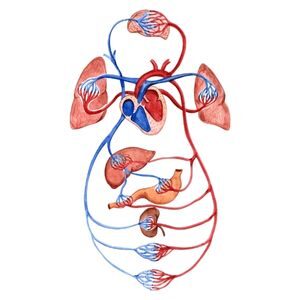
| Subtopic | Subtopic Number | IB Points to Understand |
| Human Nutrition | D.1 | The essential nutrients needed by the human body are: Essential amino acids, Essential fatty acids, Minerals and Vitamins
Amino acids: Out of total 20 amino acids, 9 are essential amino acids which us be supplied in our regular diet Minerals: These are the inorganic substances which are mostly taken in the ionic form (i.e. as electrolytes) and are needed in very small quantities. Vitamins: These are organic molecules, which are taken as part of diet but many of them are also synthesised in our body. Fatty acids: Omega-3 and omega-6 are the two essential fatty acids that need to be taken in our diet. Malnutrition is the result of intake of an unbalanced or improper diet. The diet can be unbalanced or fail to provide essential nutrients leading to starvation, or it may have excess amounts of carbohydrates and fats leading to overweight. Consequences of overweight: Hypertension, Type II Diabetes |
| Digestion | D.2 | Secretions through exocrine glands are necessary for digestion
There are three glandular secretions; HCl, pepsin and mucus which are produced by three glandular cells present in the gastric pits. Gastrin (a hormone secreted by endocrine gland) is also released due to this response which results in even more secretion of HCl and pepsinogen. Helicobacter pylori neutralises the acid in the stomach but causes its own infection that leads to gastritis and ulcers or even cancer if prolonged. Absorption of the digested food occurs in the small intestine lined by villi. Villi further contain projections called microvilli for even better absorption. Molecules absorbed in two ways: Active Transport Mechanism and Pinocytic vessels |
| Functions of the Liver | D.3 | Two major blood vessels; hepatic portal vein and hepatic artery, flow blood in the liver which exits by only one (hepatic vein).
The capillaries of the liver which receives blood from the two blood vessels are called sinusoids. Specialised leukocyte cells called Kupffer cells are present inside the sinusoids which help in recycling of older erythrocytes by breaking down its haemoglobin. Liver:
The liver intercepts blood from the gut to regulate nutrient levels. |
| The Heart | D.4 | Heart is made up of cardiac muscle which has sarcomeres like in skeletal muscle.
Two atrioventricular valves on left and right side of the heart, separating left atrium from the left ventricle and right atrium from the right ventricle. These two valves are called bicuspid or mitral valve and tricuspid valve respectively of the left and right side. The sounds of the heart i.e. lub and dub comes from the closure of these valves timely. Veins have valves which prevents the backflow of the blood A specialised tissue called sinoatrial node (SA node) is present in the right atrium, it is also known as pacemaker. When SA nodes send signals, the Atrioventricular (AV) node receives it with a delay and sends the signal for the contraction of both the ventricles. The synchrony between the atria and ventricular contraction is maintained by these electrical signals. When the heart stops working (cardiac arrest) or is no longer in sequence with the set of electrical impulses of a cardiac cycle (arrhythmia), defibrillators could be used. Thrombosis: A condition in which a clot is formed within a blood vessel causing blockage. There are two values of blood pressure; systolic pressure (when arteries are contracting) and diastolic pressure (when arteries are resting). |
| Hormones and metabolism | D.5 (HL) | In the Endocrine system of hormone secretion, the hormones are secreted directly into the bloodstream which is accepted by the receptor molecules of the target cells.
Endocrine glands include Pituitary, Thyroid, Adrenal, etc 2 types of hormones:
The Pituitary gland is called the master gland because it secretes most of the hormones to stimulate a certain function in the body. Two lobes that act as glands: Posterior and Anterior Hormones are produced in the hypothalamus and travelled down to the pituitary to be secreted. Hormones secreted by the pituitary gland controls growth, any developmental changes, reproduction and homeostasis |
| Transport of Respiratory gases | D.6 (HL) | Each haemoglobin molecule inside each erythrocyte cell can occupy four oxygen molecules at most and one CO2 molecule. Haemoglobin changes its shape on addition of oxygen molecule
Myoglobin molecules can occupy only one oxygen molecule. Foetal haemoglobin has much more affinity for oxygen than adult haemoglobin Carbon dioxide transport: It is dissolved in blood plasma in some amount, some is carried by haemoglobin (causing Bohr shift) and most of it is converted into bicarbonate ions. Ventilation rate is controlled by the respiratory centre in medulla oblongata. Chemosensors are present in the inner walls of aorta and carotid arteries, which detect the CO2 levels in the blood |
Frequently Asked Questions (FAQs)
Q1: What topics are covered in the IB Biology syllabus?
A: The IB Biology syllabus covers a wide range of topics, including cells, genetics, ecology, evolution, physiology, and biotechnology. It also includes a focus on scientific inquiry, experimental design, and data analysis.
Q2: How is the IB Biology course assessed?
A: The IB Biology course is assessed through a combination of internal and external assessments. Internal assessments include lab work, field work, and other practical activities, while external assessments include written exams and a scientific investigation.
Q3: Which topics are given the most weightage during assessment?
A: In the International Baccalaureate (IB) Biology syllabus, each topic is given a different weightage based on the number of instructional hours allocated to it. Topics that are given more weightage include Human Physiology, which covers approximately 24 hours of instruction and includes topics such as the circulatory system and digestion; Evolution and Biodiversity, which covers approximately 25 hours of instruction and includes topics such as natural selection and classification; and Molecular Biology, which covers approximately 22 hours of instruction and includes topics such as DNA replication and photosynthesis. However, it’s important to note that all topics in the syllabus are important and are designed to provide a comprehensive understanding of the subject.
Q4: How is the IB Biology course different from other high school biology courses?
A: The IB Biology course is designed to be more rigorous and in-depth than other high school biology courses. It emphasizes a conceptual understanding of biological concepts, as well as practical skills such as experimental design, data analysis, and scientific communication.
Q5: What are the benefits of taking the IB Biology course?
A: Taking the IB Biology course can provide students with a strong foundation in biology that will prepare them for future studies in the field. It can also help students develop critical thinking and problem-solving skills that are valuable in a wide range of careers. Additionally, the IB Biology course is recognized by colleges and universities around the world, which can be beneficial for college admissions.

